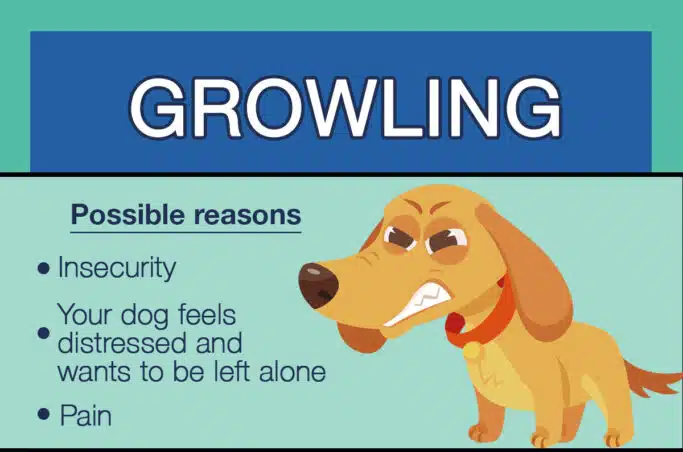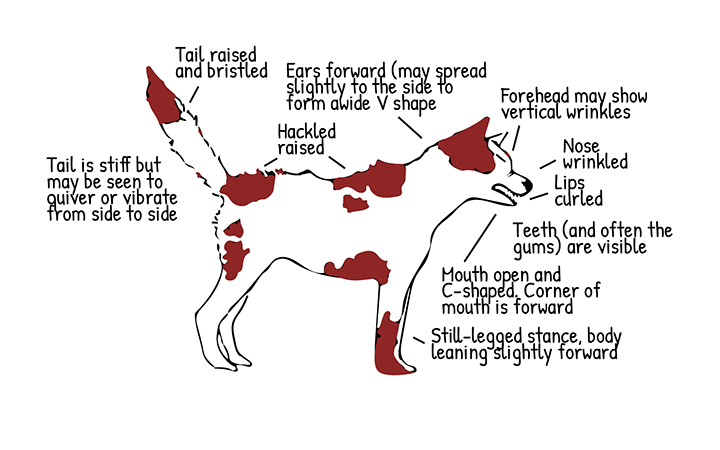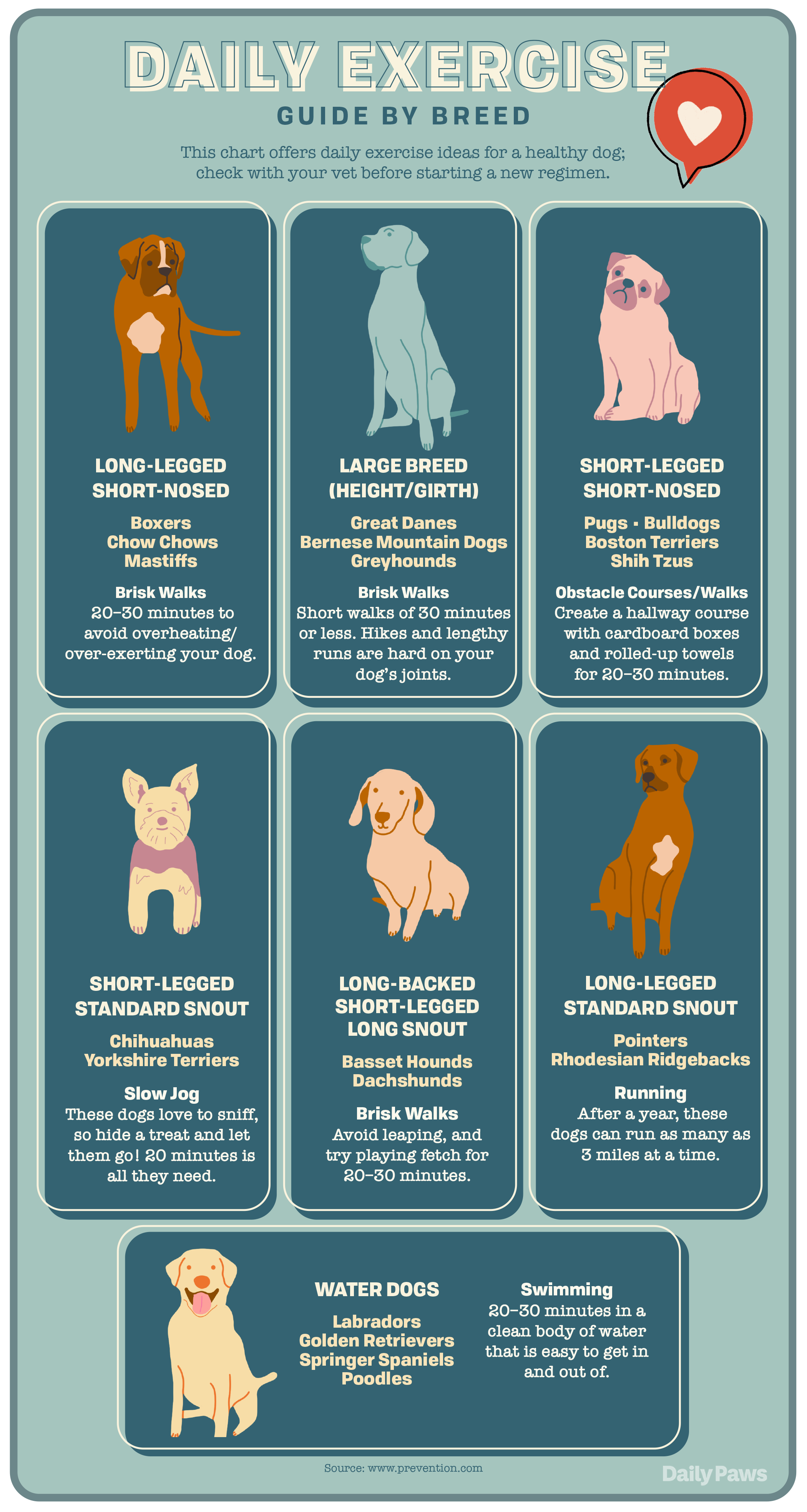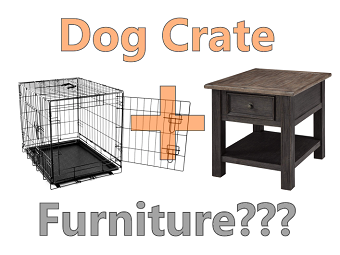While aggression is a part of natural behavior for dogs in the wild, most domesticated dogs are bred as well as trained specifically to not display this type of behavior. Yet aggression is inherent to dogs given there is an underlying trigger. Understanding why “the good” is becoming “the bad” and turning into “the ugly” is the key to knowing how to stop puppy aggression.
Worried much? Don't be because you are exactly where you need to be right now. Our guide knocks on some of the most important lessons on pup aggression. But the best part is that not only does it pinpoint the signs of aggression but different accurate methods to calm down the mini-hulk before it shatters the windows with its uncontrollable rage.
By the time you finish soaking up all the goodness from this article, you will be clear about the right methods to calm your aggressive puppy and make those walks in the dog park fun again.
7 Signs Of Puppy Aggression Every Owner Should Watch For
Identifying signs of aggression in your adorable little pup is an absolute must. Knowing these signals like the back of your hand is the first and most important step to preventing any potentially dangerous incidents from happening.
You can take charge of your puppy's aggressive behavior by learning to recognize these warning signs and responding with the appropriate corrective action to stop puppy aggression. Here are 7 signs of puppy aggression that you should know:
1. Growling
Growling is often the first warning sign of aggressive puppy behavior that could escalate quickly. Your puppy could be feeling uncomfortable, insecure, or even afraid of other dogs which leads to potentially dangerous situations. Wake up and take action. Ignoring the situation won't make it disappear.
2. Biting
Let's be clear here – biting is a normal puppy behavior and it's how they explore their environment, learn new things, and play with their littermates. However, when puppy biting becomes aggressive puppy behavior, it's a different story altogether.
If your puppy bites excessively, especially when they're frustrated or afraid, it's a clear sign that they're not comfortable in their environment. This way they will eventually resort to aggression to channel their emotions.
3. Snarling
When your pup starts snarling, it's not typical puppy play behavior anymore that you can brush off. In fact, this sign of aggression should not be ignored as it could be a warning that something is not right.
Your puppy might be feeling fearful or threatened and their natural response is to lash out in self-defense. Turning a blind eye to this early warning sign could lead to more serious problems down the line, like biting or other aggressive behaviors, and these sweet little furballs can grow into aggressive adult dogs, putting themselves and other dogs at risk.
4. Stiff Body Posture
One of the telltale signs of aggressive puppy behavior is a stiff body posture. This behavior can be a sign of possessive aggression where the puppy feels the need to protect what it thinks of as its own. It shows that the puppy is tense and may be preparing to attack.
But don't be quick to jump to conclusions when you see your puppy with a stiff body posture. Just because they appear aggressive doesn't always mean they are. Sometimes, they're just feeling curious or extra alert. Know their quirks and habits so you can spot the signs of aggressive behavior versus normal dog behavior.
5. Raised Fur On The Back
If you see your pup with raised fur on its back, don't ignore it. This is a major sign of aggressive puppy behavior and could have serious consequences if not addressed. When puppies feel threatened or aggressive, they often raise their fur as a warning signal that they're not to be messed with.
While it's true that some pups may raise their fur when playing, distinguish between normal puppy play behavior and aggressive puppy signs.
6. Whale Eye
If you notice your furry friend is giving you whale eye, it is a telltale sign of territorial aggression. When a puppy feels aggressive, it uses this powerful stare to assert its dominance and challenge other puppies or even humans.
So next time you see your little furball engaging in this behavior, don't brush this off as just a part of normal puppy play as prolonged eye contact can quickly escalate into full-blown aggressive behavior.
7. Dominance Displays
When a puppy is feeling dominant, it won't hesitate to exhibit its aggression through a series of dominance displays. Whether it's standing tall over other dogs or pushing its way through the crowd, these displays are clear signs that the puppy is feeling dominant and unafraid to show it.
In the wild, establishing a hierarchy is crucial to a pack's survival and that instinct remains with our domesticated dogs. By engaging in these displays, your dog is trying to establish their place in the pack and it won't hesitate to use aggression to do it.
Keep an eye on your dog’s behavior patterns during puppy play. These displays can be a warning sign of the dog's aggression and you should recognize them early on. Think of these signs as potential warning signals but don't automatically assume them to be a precursor to puppy aggression. If you notice several of these signs happening at the same time, there's a higher chance of the dog displaying aggressive behavior.
Calm Your Puppy's Aggression With These 7 Proven Methods
Fear, possessiveness, illness, and other underlying issues can all contribute to aggression in dogs. No matter the reason behind your pup's aggression, these 7 effective techniques will help you take control of your puppy's behavior and restore peace in your home.
I. Redirecting Attention
Redirecting attention can help distract your puppy from aggressive behavior and focus their attention on something else. Here are some ways to redirect your puppy's attention and calm its aggression.
- Change the environment: Take your puppy to a different room or outside to a new area where there are different sights, sounds, and smells. This can help to shift their focus away from whatever was causing their aggressive behavior and help them to calm down.
- Use a training technique: Teach your puppy to make eye contact with you on command and then use this technique to redirect their attention when they start to display aggressive behavior.
- Provide a sensory distraction: You can turn on some calming music or use aromatherapy to create a soothing environment. You can also provide your puppy with a textured surface to explore, like a crinkly blanket or a knotted rope. These types of distractions can help your puppy to focus on something other than their aggression.
- Use your voice: Use clear and consistent commands to distract your pup and get them focused on something else.
- Try physical cues: Physical cues, like a gentle pat on the back or a quick tug on the leash, can also help redirect your puppy's attention and calm its aggression. Be careful not to be too forceful or aggressive yourself.
II. Time Outs
A timeout is a training technique that involves removing the puppy from the situation where the undesirable behavior is occurring. In essence, it's a time-out from the fun and games that they were enjoying. Sometimes, all they need is a little time to themselves to cool off and think about what they've done
To use timeouts effectively, you need to be consistent and clear in your actions. The moment your puppy becomes aggressive, you should immediately remove them from the situation and put them in a designated timeout area.
This can be a separate room as long as it's a calm and quiet environment. Avoid using the same area where your puppy usually sleeps or eats. This way, your pup will not associate the area with negative experiences.
We know it's tempting to try to soothe your puppy during the timeout but this is counterproductive. Instead, you should remain calm and avoid giving your puppy any attention. Any type of attention, whether it's encouragement or scolding, will only reinforce the behavior. Your puppy needs to learn that being aggressive is not a way to get attention.
How long should the timeout be? It depends on your puppy's age and the severity of the behavior. Generally, timeouts should be no longer than a few minutes for puppies until they’ve calmed down. Dogs learn by association, so any timeout longer than a few minutes becomes ineffective because, by that time, they would have forgotten why they were in timeout in the first place.
Remember that timeouts are not a punishment. They are simply a way to remove your puppy from a situation and give them a chance to calm down.
III. Physical Exercise
Many pet owners are unaware of the power of physical exercise in calming their puppies. By getting your puppy moving and expending excess energy, you can reduce their aggressive behavior and provide them with a healthy outlet for their energy.
It all starts with finding the right exercise for them. Different breeds have different energy levels so research and understand what kind of physical activity is suitable for your puppy.
Start with short sessions and gradually increase the time and intensity of the exercise as your puppy becomes more accustomed to it. Don't forget to keep an eye on your puppy's behavior during exercise. You want to make sure they're not pushing themselves too hard or getting too rough and tumble
You can also use playtime as a way to reduce your puppy's aggression. Tug-of-war or fetch can help your puppy release pent-up energy and provide them with mental stimulation. Always set boundaries and rules during playtime to prevent your puppy from becoming too aggressive or dominant.
IV. Implementing A Consistent Daily Routine
It's all about consistency – staying on top of their training day in and day out is the key to success. With a consistent daily routine, your puppy will be less likely to act out in aggressive ways.
A regular feeding schedule is particularly important for aggressive puppies. When your puppy's tummy starts to growl, it can become irritable and prone to outbursts. By establishing a consistent feeding schedule, the puppy will know when it will be fed and won't become excessively hungry. Setting up a daily exercise regime is equally important. It serves as an outlet for excess energy, helps the puppy relax, and prevents boredom and frustration.
Set a regular schedule for taking the puppy outside to eliminate to reduce the puppy's anxiety. The same goes for a regular sleep schedule. Puppies need structure and predictability to feel safe and secure and a fixed schedule for potty and sleep can provide just that.
V. Using Pheromone Products
Pheromones are chemicals that animals naturally produce to communicate with each other and are used to convey a range of emotions. Pheromone products for pets are designed to mimic these natural chemicals and can be used to help soothe your puppy. We don’t rely on these products but you can use them in worst-case scenarios.
For best results, introduce the pheromone product into your puppy's environment. Here are some examples of different types of pheromone products:
- Diffusers: Pheromone diffusers release a synthetic version of the pheromone that mother dogs produce to calm their puppies. These diffusers are used to create a calming environment for your puppy, especially if they are experiencing separation anxiety or fear-related aggression. Some diffusers reduce anxiety related to thunderstorms and other loud noises.
- Collars: Pheromone collars work similarly to diffusers but they are worn by your puppy. These collars release the calming pheromone throughout the day which helps soothe your puppy's anxiety and reduce their aggression.
- Sprays: Pheromone sprays can be used on your puppy's bedding or in their crate to create a calming environment. They can also be used during car rides, visits to the vet, or other situations where your puppy is experiencing stress or anxiety.
Follow the instructions carefully and use the product as directed. When using pheromone products to calm your puppy's aggression, be patient and consistent.

Another option with oils is to use a diffuser kit like this one from Adaptil. The Adaptil Dog Calming Pheromone Diffuser kit works just like a glade plugin in your home, but instead of just a fresh scent it helps put calming pheromones in the air to calm your dog.

Drug-Free calming solution that is recommended by vets. Unlike the diffuser, you can use this option when necessary and don't need to take up one of your outlets.
VI. Using Interactive Toys
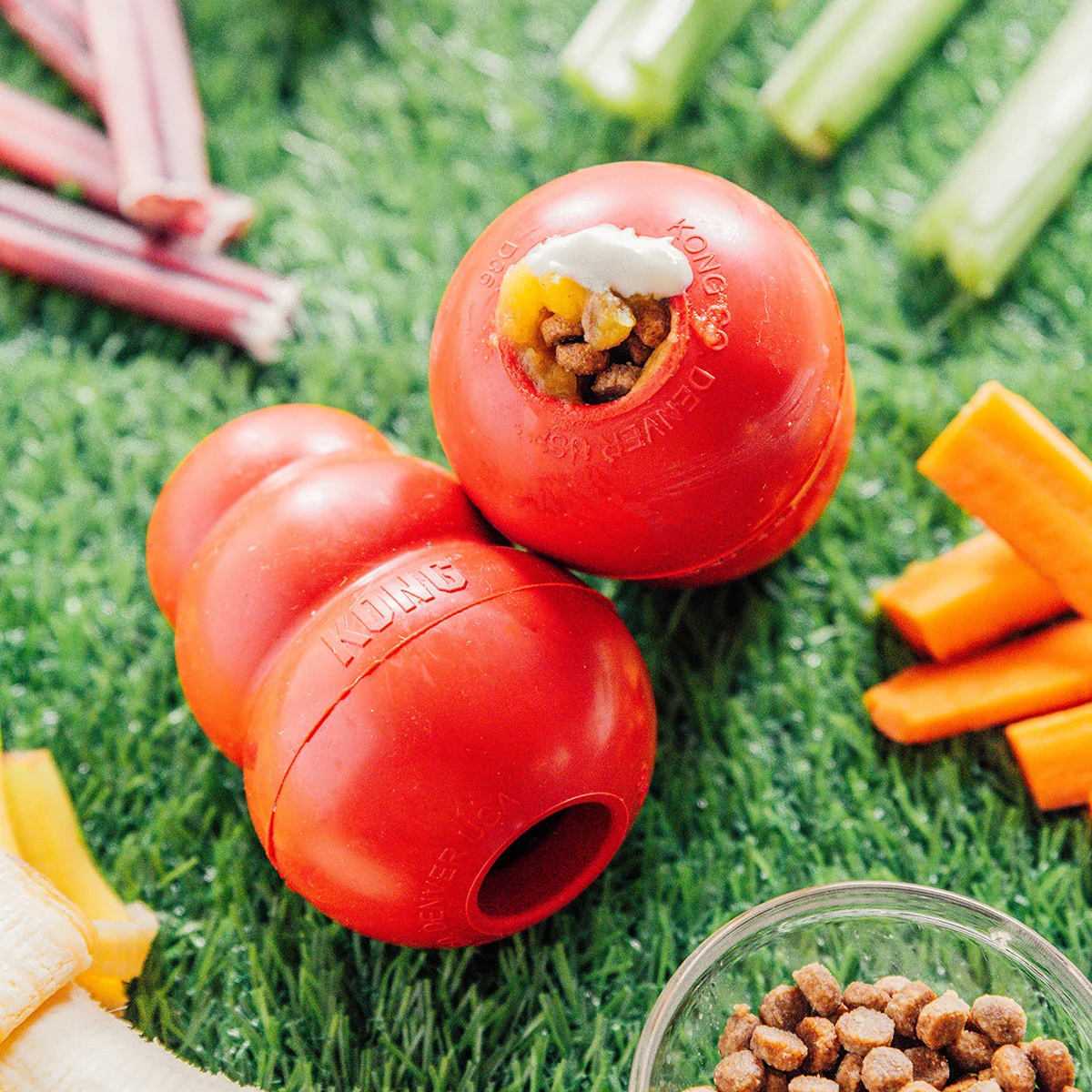
Image Source
Interactive toys are the ultimate weapon in your arsenal to redirect your pup's energy and show them how to behave like a good doggo. Not only do these toys keep their brains sharp but they also provide a much-needed outlet for physical activity. Here are some major types of interactive toys that you can consider:
- Puzzle Toys: These are designed to stimulate your puppy's mental abilities and keep them engaged. Puzzle toys are also an excellent way to reduce boredom which can lead to aggressive behavior.
- Chew Toys: These toys are great for puppies that are teething and love to chew on everything in sight. Chewing also helps release endorphins which helps calm your puppy down and reduce their aggression.
- Squeaky Toys: Squeaky toys can be a fun way to keep your puppy entertained and engaged. These toys make a noise when your puppy bites or chews on them which can be satisfying and help reduce their anxiety.
- Kong Toy: This durable and versatile toy is designed to keep your pup engaged and occupied for hours. If you notice your pup becoming agitated or aggressive, you can use the Kong toy as an alternative activity to redirect their attention.

- The extreme Kong is our favorite of the Kong line of toys. Fill it with Peanut Butter and your pup will love it for hours on end.

Puzzle toys are very popular and make your dog work for their food/treat. Mental stimulation helps reduce anxiety.

While a bone might be the most natural thing for a dog to chew on, the next is a stick. So Benebone offers the Maple Stick and the Bacon Stick.
VII. Seeking Professional Help
Recognize when your puppy's aggression is beyond your control and requires professional help. While some pet owners may try to manage their puppy's aggression on their own, a professional dog trainer has the skills and expertise needed to tackle even the toughest cases.
So if your puppy's aggression is becoming too much to handle, don't wait any longer. Get professional help from the best in the business – Suburban K9.
At Suburban K9, our professional dog trainers are experts in training all dog breeds and ages. Our personalized in-home training sessions for puppies are specially designed to fix aggression and other behavioral issues.
During our in-home puppy training classes, we give your pup the focused attention they need to tame its aggressive side. Our trainers work closely with you and your pup, right in the comfort of your own home. They will give you customized homework after each intense training session that will help you and your puppy succeed like never before.
At Suburban K9, we have the ultimate training technique that will unleash your pup's full potential – the balanced training method. It combines the power of positive reinforcement with the precision of fair corrections to tackle aggression head-on. We'll encourage your puppy for good behavior while also providing gentle guidance to keep them on the right track.
We understand the importance of rules and discipline and that's why we focus on teaching your pup right from wrong. If they don't listen, don't worry – our trainers will provide a fair correction that will reinforce the lesson and make sure your pup understands who's in charge.
By "correction," we simply mean enforcing the rules and gently nudging your pup in the right direction. No need for any harsh tactics here.
Conclusion
Appearances can be deceiving at times. What may seem like a cute, unharming little pup can turn out to be the most feisty of the lot and it may end up in biting that could leave you seeing the stars.
So basically your furry little tyrant needs to learn a thing or two about how to keep a cool head. Our revealed expert moves tell you how to stop puppy aggression. So it's time to follow these moves and help turn that snarl into the most submissive grin.
Suburban K9 is a professional dog training company that produces lasting results. Our team of experienced trainers uses a balanced approach to provide customized training solutions for your furry friend. With one-on-one attention, we focus on specific areas of training that your pup needs to work on. Contact us today to schedule your consultation and we guarantee that there will be no looking back.
The article above contains Affiliate Links from Amazon and other companies. If you visit their site and buy the product, we will get a small commission. Please know that we only recommend products we love and would never recommend a product we think is less than great. We look at and try hundreds of products before we ever recommend them to our clients!
